Fly Control and Extermination
Contact or Schedule Service
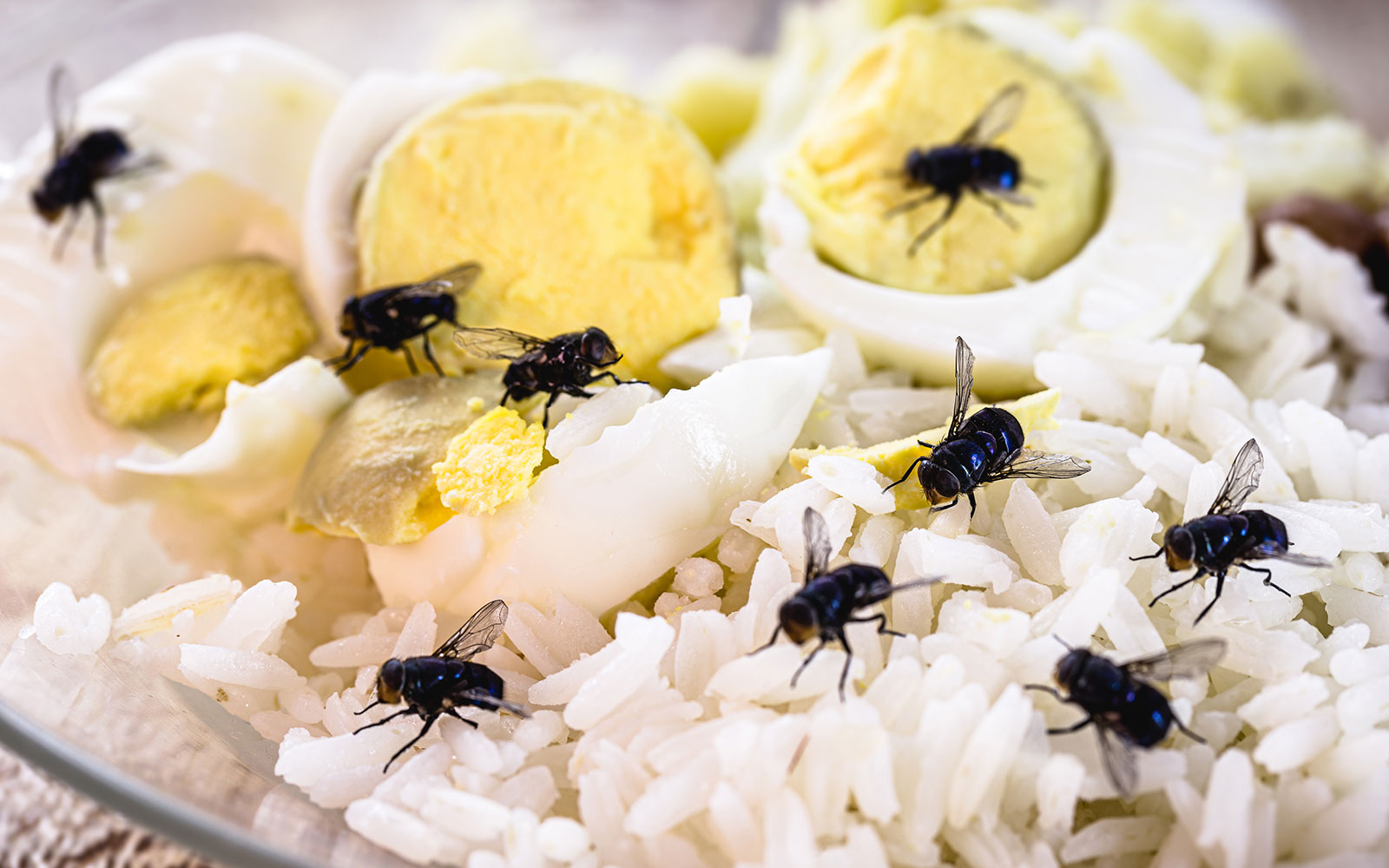
Fly Control and Extermination
Flies in the house are more than just an annoyance. They can also transmit disease by picking up germs and then transferring them to our food and water. Fly infestation can cause issues like dysentery, food poisoning, and even tuberculosis. Count on Maximum Pest Management for professional fly control for homes and businesses in Wichita – no contracts required.
Maximum Pest Management is an experienced fly pest control company serving residential and commercial customers in the Wichita, KS, area. We’re a family-owned, local extermination company with more than 20 years of experience. You can count on use to identify and treat all types of flies, including house flies, fruit flies, blow flies, biting flies like deer flies, black flies, horse flies, and more.
Your fly control service will start with a free inspection to assess your fly problem and check for any other types of pests. Then, we’ll recommend your custom treatment plan. We’ll never require you to sign a contract, so you can use our recommendations to decide how often you’d like to have your home treated for flies.
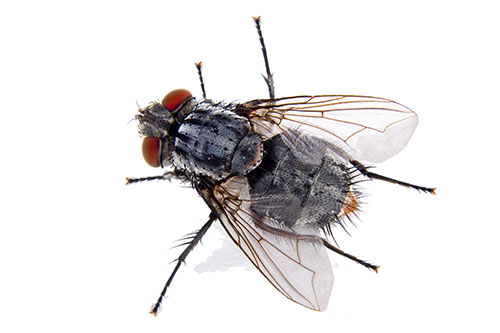
Signs of Fly Infestation
Flies will definitely let you know they’re there. You’ll see and hear them buzzing around, usually near food or garbage. Even if you don’t see live flies, you may find fly larvae, also known as maggots, in trash. These small, white worm-like pests will quickly grow into adult flies. In addition to the common house fly, you may see tiny fruit flies flitting around fresh fruit or sugary drinks that are left out on the counter.
How We Treat for Flies
The fly exterminators at Maximum Pest Management start by inspecting your home for flies and other pests. We’ll determine the types of flies in your home and check for places they may be depositing eggs. Then, we’ll treat the perimeter of your home’s interior and exterior to quickly get rid of the adult flies. If we see any opportunities to seal gaps or cracks that could let flies into your house, we’ll point those out.
Ways to Prevent Flies Around the House
Start by doing as much as you can to prevent flies from getting into your home. Fix any holes in window screens, make sure any gaps around windows or doors are sealed, and don’t leave exterior doors standing open. Of course, flies move quickly, so they’ll inevitably sneak in from time-to-time as you’re entering or leaving the house. House flies only live for about 24 hours but they can lay hundreds of eggs in that time, so if you can block their food sources, you’ll keep them from reproducing. Keep food stored in airtight containers and make sure trash can lids are closed securely.
Reviews for Maximum Pest Management
Signs of Fly Infestation +
Flies will definitely let you know they’re there. You’ll see and hear them buzzing around, usually near food or garbage. Even if you don’t see live flies, you may find fly larvae, also known as maggots, in trash. These small, white worm-like pests will quickly grow into adult flies. In addition to the common house fly, you may see tiny fruit flies flitting around fresh fruit or sugary drinks that are left out on the counter.
How We Treat for Flies +
The fly exterminators at Maximum Pest Management start by inspecting your home for flies and other pests. We’ll determine the types of flies in your home and check for places they may be depositing eggs. Then, we’ll treat the perimeter of your home’s interior and exterior to quickly get rid of the adult flies. If we see any opportunities to seal gaps or cracks that could let flies into your house, we’ll point those out.
Ways to Prevent Flies Around the House +
Start by doing as much as you can to prevent flies from getting into your home. Fix any holes in window screens, make sure any gaps around windows or doors are sealed, and don’t leave exterior doors standing open. Of course, flies move quickly, so they’ll inevitably sneak in from time-to-time as you’re entering or leaving the house. House flies only live for about 24 hours but they can lay hundreds of eggs in that time, so if you can block their food sources, you’ll keep them from reproducing. Keep food stored in airtight containers and make sure trash can lids are closed securely.
Common Flies Native to Kansas
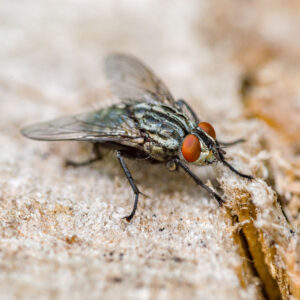
House Fly
The common house fly (musca domestica) is about ¼ inch in length with a gray body covered in hair. When viewed up close, you can see four black stripes on a house fly’s thorax.
House flies are a type of filth fly, so named because they typically eat and lay their eggs on garbage, dead flesh and feces. As a result, they’re known to carry disease and bacteria. Because these flies regurgitate on their food to liquefy it before ingesting it, they can easily spread those germs and diseases.
A house fly will lay its eggs in a food source so its larvae will be able to feed after hatching. That’s why it’s so important to clean up and put away any sources of food for house flies, like trash, leftover food, dirty diapers, etc.
The house fly’s larvae are small, legless maggots. When maggots are ready to form their pupal stage, they crawl away from the food source in which they hatched. Then, they develop a dark brown cocoon called a puparium, in which they become adult house flies.
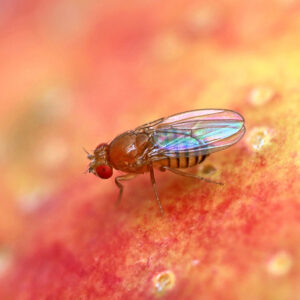
Fruit Flies
Fruit flies (drosophila melanogaster), or vinegar flies, are small filth flies.
You may see them hovering around ripe fruit or sweet drinks in the kitchen or outdoors.
The adult fruit fly is about the size of a gnat and usually has red eyes and a body that’s tan in color.
Fruit flies love anything sweet or fermented, such as ripe or rotting fruit and sweet liquids like syrups, liquor, soda or vinegar.
Female fruit flies lay their eggs in or near food sources, so it’s important to throw away fruit before it gets overripe and to keep sweet liquids in closed containers.
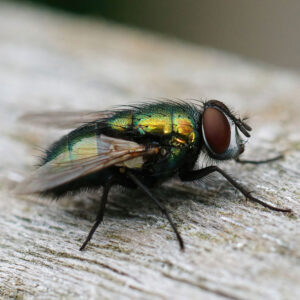
Blow Fly
Although there are a number of other filth flies that can be found in Kansas homes and businesses, blow flies are another type to pay particular attention to.
Blow flies (calliphoridae) are also eferred to as bottle flies because the adults are shiny green and blue like colored glass bottles. Blow flies are slightly bigger than house flies.
Like house flies, blow flies love garbage, but they also like to lay their eggs inside dead animals. If you’ve ever seen carrion on the side of the road and it looks bloated, that’s likely because of the blow fly larvae developing inside. In fact, that’s how these flies got their name.
Blow flies don’t bite humans, but they can still be dangerous to both humans and pets because their maggots can develop in living animals. This results in myiasis, a parasitic condition that can lead to death.
Because of their appetite for carrion, if you see large numbers of blow flies in your house, that’s a good sign that you may have a rodent problem and/or a dead animal in the walls or attic.

House Fly+
The common house fly (musca domestica) is about ¼ inch in length with a gray body covered in hair. When viewed up close, you can see four black stripes on a house fly’s thorax.
House flies are a type of filth fly, so named because they typically eat and lay their eggs on garbage, dead flesh and feces. As a result, they’re known to carry disease and bacteria. Because these flies regurgitate on their food to liquefy it before ingesting it, they can easily spread those germs and diseases.
A house fly will lay its eggs in a food source so its larvae will be able to feed after hatching. That’s why it’s so important to clean up and put away any sources of food for house flies, like trash, leftover food, dirty diapers, etc.
The house fly’s larvae are small, legless maggots. When maggots are ready to form their pupal stage, they crawl away from the food source in which they hatched. Then, they develop a dark brown cocoon called a puparium, in which they become adult house flies.

Fruit Flies+
Fruit flies (drosophila melanogaster), or vinegar flies, are small filth flies.
You may see them hovering around ripe fruit or sweet drinks in the kitchen or outdoors.
The adult fruit fly is about the size of a gnat and usually has red eyes and a body that’s tan in color.
Fruit flies love anything sweet or fermented, such as ripe or rotting fruit and sweet liquids like syrups, liquor, soda or vinegar.
Female fruit flies lay their eggs in or near food sources, so it’s important to throw away fruit before it gets overripe and to keep sweet liquids in closed containers.

Blow Fly+
Although there are a number of other filth flies that can be found in Kansas homes and businesses, blow flies are another type to pay particular attention to.
Blow flies (calliphoridae) are also eferred to as bottle flies because the adults are shiny green and blue like colored glass bottles. Blow flies are slightly bigger than house flies.
Like house flies, blow flies love garbage, but they also like to lay their eggs inside dead animals. If you’ve ever seen carrion on the side of the road and it looks bloated, that’s likely because of the blow fly larvae developing inside. In fact, that’s how these flies got their name.
Blow flies don’t bite humans, but they can still be dangerous to both humans and pets because their maggots can develop in living animals. This results in myiasis, a parasitic condition that can lead to death.
Because of their appetite for carrion, if you see large numbers of blow flies in your house, that’s a good sign that you may have a rodent problem and/or a dead animal in the walls or attic.
